I don't know anyone who can say that 2001 wasn't a strange
year. Considering that the prelude to it was the 2000 Presidential
election, we really should have been prepared for anything, I suppose.
It was a truly zine-worthy year (especially for me), but unfortunately,
for much of it, I was too busy to do any writing, let alone keep up
with my mail...
January
Early in the year, we decided
that it was time for us to have a baby. Let's face it, if you watch
any daytime TV shows you know that people from the shallow end of the
gene pool are pumping out kids like there's no tomorrow, and someone's
going to have to be in charge of them someday.
March 9
We visited some friends down south (see Shouting At The Postman #45).
April 28
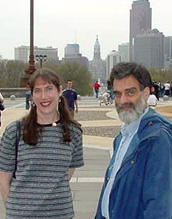
Writer and poet Eric Chaet
visited Philadelphia with his wife Brenda
for a convention she was attending. Mary and I took Eric to the Art
Museum and the Rodin Museum while his wife was attending workshops.
Then, we brought the two of them to our favorite Chinese restaurant for
some fantastic vegetarian mock meats (well, we think they're fantastic...
we haven't had real meat in a long time so they could really be
nothing like actual meat). We had a great time with them, spending hours
in the restaurant talking.
May 11
We found out that Mary is pregnant. We were very excited and surprised
because we were told that it could take a long time to conceive. Being
superstitious, we decided to keep the pregnancy a secret from everyone
but Mary's gynecologist until the end of the first trimester. Also
we started to pay attention to whether Mary was eating the right foods.
Being a vegetarian makes you paranoid about such things, especially after
what everyone tells you your whole life about how vegetarians don't
get enough protein, calcium or iron (truth is, people who eat meat get
entirely too much of those things). Mary was careful to eat the
right foods, and to keep track of everything she ate to make sure she
was getting proper nutrition.
May 19
After years of night and weekend classes, Mary received her Master's
degree. We spent the day and night with her parents, but we didn't
want to break the news about the baby until the first trimester ended
at the end of June. Roughly one third of all pregnancies end during the
first trimester, and telling everyone that the baby didn't make
it would have been more horrible than waiting. It was extremely difficult
to keep something so big a secret from everyone, especially people who
have been hinting left and right that they would like to be grandparents.
June 10
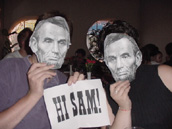
Mail artist Crazy Ré visited Philadelphia. We met her at our favorite Chinatown restaurant
(once again) for more vegetarian mock meats. We posed for this picture for Scientist Sam, much
to the amusement of our fellow diners. Afterwards, we wandered the city looking for someplace
to hang out. We ate dessert at our favorite Mexican restaurant, then Ré interviewed me with a
tape recorder in the train station. Urine-smelling homeless men kept interrupting us to try to
panhandle. She claims that the interview is really funny, despite the fact that I found myself
unable to form coherent sentences once the recorder was turned on.
June 25
At the gynecologist's office, we heard the baby's heartbeat for
the first time. It was a beautiful sound, and suddenly, this abstract
idea of a child seemed so real for the first time. The next day we started
telling people about the pregnancy.
July 1-5
Mary's mom rented a cabin in a northwestern Pennsylvania state
park and invited us to visit. It's kind of like camping, except
you have a refrigerator, electricity and a stove, and the great hardship
is that the bathroom is a few yards up a hill and full of moths.
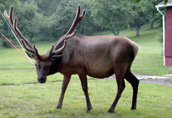
We had a lovely time hiking in the woods, visiting the
Kinzua Viaduct railroad trestle bridge and viewing wildlife. We went to the
nearby Pennsylvania Elk Range, and at the
official lookout post, we could barely make out tiny specks in the distance that were
either elk or horses. Then, on the way back to the cabin, we spotted a massive bull
elk standing next to the road on someone's front lawn. It was astonishingly big, with
an enormous rack of antlers. There was a line of cars on both sides of the road full
of gawking tourists who blindly ignored oncoming traffic to get a good picture of the elk.
Staying in a cabin was great, but it was difficult to feel that we were roughing it
when we found ourselves visiting the nearby Wal Mart every day for supplies. On the last
night of our trip, we enjoyed the impressive Independence Day fireworks in a nearby town.
August 18-22
We had been planning a trip to Europe with Mary's dad for early
2002, but when we told him about the pregnancy in late July, he decided
that we needed to have our trip immediately. Three weeks later we were
in Barcelona.
Peak summer tourist season isn't the best time to visit Spain,
but since there was a baby on the way we didn't have a choice. Although
the temperature wasn't terribly high, the Spanish sun is hot. Saying
that is not enough... perhaps the fact that we needed to shower and change
our sweat-saturated clothes twice a day better illustrates what kind
of heat we're talking about here. Still, we were careful that Mary
didn't overheat or overexert herself, and that she drank plenty of bottled water.
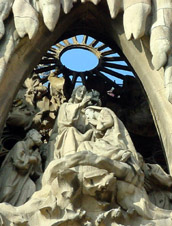
The romance of Spain, however, is not ruined by the heat; it merely
adds to the otherworldly atmosphere of Gaudí's architecture,
in which solid concrete surrenders to the oppressive mid-day sun and
drips down the façade of Sagrada
Familia, and the concrete-and-tile crosses wobble like they're made of rubber.
Even the crowds of peak-season European tourists do not tarnish the
magic of Barcelona, merely adding to the impression that the city is
a giant, sweaty outdoor festival. And we would gladly put up with eating
the only two vegetarian options in most restaurants (frozen cheese pizza
and vegetable paella, and we strongly suspect that most chefs use chicken
broth in the paella) every day for a month to stay there if need be.
You don't go there for the food, the crowds or for the climate...you
go there for something entirely and uniquely Catalan which can only be
partially understood in the art of Salvador Dalí.
On the third day we rented a car and drove to Figueres to visit the
museum Dalí himself created in the 1970s, where he died in 1989
and where his remains reside to this day. After viewing the many excellent
installations and exhibits, we pressed on to Cadaqués and finally
Port Lligat to tour Dalí's home. Here it all falls into place:
the insane heat of the sun, shimmering white walls, the beautiful rocks,
the stoic Spanish fishermen who pull their boats to a few feet of Dalí's
front door and mend their nets on his patio, as they have for perhaps
hundreds of years. This was why we came to Spain.
September 6

This is the first picture of our child,
taken by an ultrasound technician. We watched in fascination as this
tiny thing moved around, stuck out her tongue and kicked her legs...of
course, at the time we didn't know it was a "her"--we
had asked the technician not to tell us the gender of the baby because
we wanted it to be a surprise, much to my mother's frustration.
September

September 21
We had bought plane tickets for the return to Atlanta long before a
group of insane individuals revealed to the world an entirely new use
for the Boeing 767. Being in an airport only ten days after the tragedy
was a surreal experience. The entire terminal was practically deserted,
and the people who were there seemed rather jittery. After finally boarding
the airplane, we discovered that there were only 12 people in the entire
cabin. The pilot came out and joked around with us to put us at ease,
because everyone had the same thing on his or her mind. Fortunately,
the flight landed safely and we were back in Atlanta for the wedding
of Tracy and Kurt. Oh happy day!
Those of you who remember Shouting At The Postman #45 know a bit
about Tracy and Kurt. This time, fortunately, we weren't staying at their house.
We, along with much of the wedding party, had been booked into a Days Inn not far
from where the wedding was to take place... the rite of holy matrimony was to be
performed on the dance floor of a country-western bar in a strip mall.
Friday night there was the wedding rehearsal in the country bar, and
the bride was becoming increasingly frantic and irritated about everything
as the evening wore on, alternately screaming and stalking away to pout.
Afterwards, we went to eat the customary "rehearsal dinner" at a diner in the same strip
mall as the bar.
The rehearsal dinner is traditionally a gift from the bride and groom
to the people in the wedding party, but we knew Kurt and Tracy didn't
have a lot of money so we didn't complain when it was announced
that we would have to pay for ourselves. When we asked if we could see
a menu, the waitress refused to bring one. "You got four choices:
chicken, pork, fish and vegetable plate." Annoyingly, she was unable
"vegetable plate" involved.
When it finally arrived after the salad, the "vegetable plate" consisted
of boiled baby carrots, mashed potatoes, and boiled sliced carrots and
zucchini which, ironically, were the same vegetables serving as the side
dishes for the pork, chicken and fish plates. After some awkward and
disturbing speeches from the bridal party, we were given our bill, and
we were horrified that we were being forced to pay $19 each for a plate
of three side dishes! It was especially infuriating in a restaurant where most entrees
cost about $7.
Finally, the big wedding day came. Mary was sequestered with the rest
of the wedding party and I was stuck in the hotel again. Honestly, I
was happy not to have to stay in that horrible house again, plus I was getting a lot of
reading done.
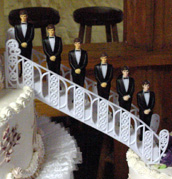
I caught a ride with several other husbands of bridesmaids to the bar
for the big event. I was impressed with how the caterer had transformed
one of the bar tops into a classy buffet of cheeses, appetizers and tasty-looking
bread. The gift table was actually the pool table with a white cloth
on top of it, underneath a giant picture of John Wayne. Near the mechanical
bull, the gargantuan cake was being assembled, with twelve tiny plastic groomsmen and
bridesmaids, as well as a cowboy bride and groom. The wall along the
dance floor, which boasts an enormous airbrushed mural of an idealized
wild west, now a boasted a huge American flag to serve as a backdrop
for the ceremony. The dance floor featured a flower-covered arch under
a neon "Budweiser" sign. It don't get too much more romantic
than this.

Finally the bride and bridesmaids arrived and the DJ played Canon for the processional,
which was the same song we used as the processional at our wedding. Truthfully it wasn't
the worst wedding ceremony I've ever seen, although having to stand on the dance floor
through the whole sermon made it a bit uncomfortable.
At last the dreaded reception began. It was dreaded because we had been
told that we would be forced to (and I shudder as I write this) Line
Dance. For the uninitiated, a "Line Dance" is where a group
of white people in western garb show their unwavering conformity by standing
in a grid-like pattern and stepping about in exactly the same pre-determined
way. In addition, line dancers are required to tuck their thumbs into
their pockets, lest someone do something spontaneous and rhythmic with
their arms. I'm sure that if Hitler were alive today, he would heartily
approve of the soulless conformity of the line dance. In preparation
for what could only be a scarringly embarrassing incident, we rented
a video from the library in a vain attempt to learn some steps. Unfortunately,
we would just mock the dancers, the music and the insipid steps instead
of actually learning anything.
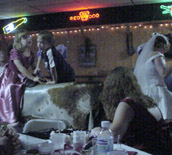
Fortunately, the bride and groom were too busy and drunk to make us
dance, and we stayed out of their way as we were seated on the complete
opposite side of the bar (near the mechanical
bull). We had a good view of the dance floor as a small group of
about 12 women did the same step over and over to a number of oddly non-country
tunes such as Brass Monkey by the Beastie Boys and Pour Some
Sugar on Me by Def Leppard. When they started playing the real country
tunes, some more people drifted onto the floor, but they didn't
stay around too long and soon the dance floor disintegrated into children
running after each other. As it was winding down, we could only think, "thank
God we didn't have to dance."
October
Envelopes full of Anthrax spores started showing up at media offices
and at the US Congress. These envelopes, it turned out, were being mailed
from Trenton, New Jersey, which is a few miles from our house and is
where I work.
October 6
Though he had reservations about flying to the United States so soon
after the terrorist attacks, Predrag "Pedja" Popovic, our friend
from Yugoslavia, decided to visit us in October. Visiting the USA isn't
an easy thing for a Serbian to do. First he had to save up nearly a month's
salary for airfare. Then, he had to endure an 8-hour bus ride to the
American embassy in Budapest to interview for a visa. Because his visa
application wasn't refused (as it can be without explanation), he
was issued a visa to visit us. So, finally, on October 6 he arrived at
Newark airport. On the way to our house from the airport, I explained
that Americans don't normally drive around with flags all over their
cars, but that it was a result of a huge surge in patriotism after the
attacks. Pedja said that during the NATO bombings of Yugoslavia in 1999,
Serbians, with their typical black humor, decorated their cars
with targets.
October 7

The next day we headed down I-95 to Washington DC to see museums, monuments
and the mall. Because it was kind of off season, and so soon after the
terrorist attacks, much of the city was eerily deserted. We weren't
allowed into some of the buildings or monuments, and security was extremely
tight in all of the museums. While we were walking toward the Lincoln
Memorial, a big helicopter came swooping overhead
from Reagan International Airport and headed for the White House.
When we got back to the hotel that night, we were surprised to learn that the US had
launched cruise missile attacks against targets in Afghanistan. That helicopter we saw was
the president returning to make the announcement from the White House. Watching the
disturbingly sports-like CNN coverage of the Tomahawk attacks with a Serbian who had been
on the other end of similar attacks only 2 years ago was dreadfully uncomfortable.
October 10
We tried to make sure at least one of us would be able to entertain
Pedja each day (we both had to work during his stay), and it was working
out pretty well. After we returned home from our DC weekend, Mary took
Pedja to Philadelphia with her so he could visit some sights. Everything
changed on the night of the 10th, however, while Pedja and I were e-mailing
pictures of him in Washington DC to his friends back home. Mary was at
the gynecologist's office for a routine exam, and I started to notice
that she was gone for a long time. After we were offline the phone finally
rang. Mary was crying and said that she had been admitted to a nearby
hospital by the gynecologist for high blood pressure.
Pedja and I rushed to the hospital to find Mary lying in a room wearing a hospital
gown, and hooked up to an assortment of machines. She said that she had been diagnosed
with something called pre-eclampsia, which could be potentially fatal for the mother
and for the baby. There was the hope that if she stayed in bed for the duration of the
pregnancy that everything would work out OK, so after a day of observation, Mary was
sent home. She was under strict orders that she was not allowed to get out of bed for
anything except to use the bathroom and to get food for herself. They would allow her
to use the stairs to go up and down once a day, and she was expressly forbidden from
watching the news.
Inevitably we were afraid that Mary's vegetarian diet caused it, but after doing
some research on the web, we found only a few unconvincing sources that claim diet
is a factor (one claimed not enough protein causes it, another claimed that too much
protein causes it, and another blamed it on not enough calcium). Doctors think it's the
result of an immune system reaction to the baby (the current accepted thesis), or that
it's linked to cold weather, or that taking aspirin every day will prevent it. Her
gynecologist chalked it up to fate. Whatever causes it, it occurs in nearly 8% of all
first pregnancies, and if it's not diagnosed early enough it can lead to liver and kidney
failure and seizures (or eclampsia), which can cause brain damage or death in the mother.
In addition, the child is at increased risk for IUGR (intra-uterine growth retardation--a
condition where the baby doesn't get enough nutrition through the restricted blood vessels
of the placenta and stops growing), prematurity and death.
At first, Mary's bed rest went pretty well and her blood pressure
was under control (we were checking it with a home blood pressure monitor).
Then, a few days later, she had another appointment at the gynecologist.
Inevitably, once she was walking around again, her blood pressure was
horribly high, and they admitted her to the hospital again. This time
they said that she would need to remain in the hospital for the rest
of the pregnancy (this was 13 weeks before she was due). We were in shock
about the whole thing, but the doctors were trying to be optimistic.
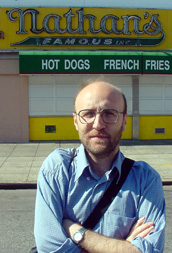
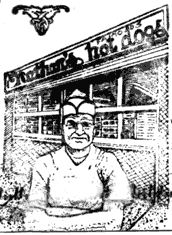
We also felt bad that Pedja had worked so hard for this vacation, only to find himself
spending so much time at the hospital. I managed to take him to New York City a few times,
which was lots of fun, but it was hard to enjoy myself not knowing what was going on at
home. While we were there, we went downtown to see ground zero, where the sheer size of
the destroyed area left us in awe. We also took the subway through Brooklyn to Coney
Island so that Pedja could see the origin of one of his favorite rubber stamps and eat
one of it's famous hot dogs.
October 17
Mary called me late at night to tell me that her doctor was transferring
her to a different hospital, this one about 45 minutes from our house,
because an ultrasound had revealed that the baby was much smaller than
she should be. The next day Pedja and I visited Mary in the new hospital
to see how she was doing, and she told me about how she had been rushed
in an ambulance with a bunch of machines hooked up to her to monitor
her blood pressure and heart rate. She was put on magnesium sulfate,
a central nervous system suppressant to prevent seizures, which made
her feel like she was going insane.
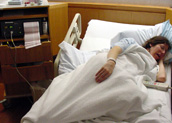
Now she was in the high-risk pregnancy ward in a hospital that specializes
in that sort of thing. The next few weeks were utter torture for her,
as she could only lay on her left side,
and wasn't allowed to even walk across the room. She was hooked
to a fetal heart monitor at all times, to make sure the baby's heart
rate was good, and her blood pressure was taken constantly. They also
started her on blood pressure medication that was safe for the baby,
although it didn't seem to have much of an effect on the blood pressure.
Some days it was good, and some days it was bad, but the idea was to
wait as long as possible before giving birth to increase the baby's
chances of survival.
Now having a Pedja at our house was becoming very strange for me because
of the constant feelings of dread I was experiencing...not knowing what
was going to happen to Mary or the baby from one hour to the next. Most
of the time I was very depressed, and I wanted to be alone, but I also
wanted to do things with him to take my mind off of everything. I'm
sure he wasn't pleased about being stuck in our house all day while
I was at work.
October 21
I took Pedja to the airport for his return home, this time without Mary,
and hoping that nothing bad would happen while I was out of contact.
Again I apologized for his vacation not going as we had planned, but
he was nothing but thankful for everything he had been able to see.
Once Pedja was gone, the house was terribly empty, and I couldn't find the energy to
do anything. Eating alone made the food seem tasteless, and I didn't have the desire to
prepare anything anyway. Sleeping alone was strange and sad, and waking up in the morning
alone over and over again made me horribly depressed. Fortunately the hospital allows
husbands to sleep over, so I got to spend a few nights camped out in Mary's room. The
hospital provided a VCR, and we watched some movies. It was almost like being home except
for the constant "thump-thump-thump" of the fetal heart monitor.
Because the baby was so small, every few minutes she would turn a little and the
monitor would stop hearing her. We would have to slather the microphone with acoustic
jelly and move it around Mary's stomach to try to find her again, but it was difficult
sometimes. If the baby was off the monitor for any length of time a nurse would come in
to see if everything was OK, and lend her expert hand at finding the baby. Often times
the baby would kick the microphone as soon as the nurse found her.
October 31
Mary called me at work and said that overnight the baby's heart
rate had slowed down. Mary was asleep at the time, but woke up to a team
of nurses in her room preparing her for an emergency C-section, with
an oxygen mask on her face. She was terrified, but the baby's heart
rate came back up. An ultrasound showed the baby in good shape, so it
was decided to keep waiting.
November 1
Mary called me again at work. This time she said, "Get over here
now!" They were preparing her to have a C-section immediately because
the baby's heart rate had slowed down again during the night. The
doctors felt that the risk to the baby was increasing, so they wanted
to get her out of there. Also, a growth scan had shown that the baby
hadn't been growing. She almost certainly had IUGR.
I drove at very unsafe speeds to make it to the hospital in time for the operation.
When I arrived, I found Mary's room empty. I asked someone where she was, and I was given
a surgical gown, shoe covers, a mask and a hat to wear. They sat me down in a hallway
outside the operating room to wait for them to finish preparing Mary for surgery.
When I was finally allowed into the OR, they were painting Mary's belly with betadine.
They led me to a chair next to Mary's head, and they erected a screen between us and her
belly so we couldn't see the operation. I held Mary's hand while a nurse told us what was
going to happen and reassured us about everything.
The surgical team came in and started to work. The nurse explained that Mary should
feel some pressure while they made the incision, and said to let her know immediately if
she felt any pain. Mary felt the pressure, and we could hear the doctors working on her,
and then after what seemed like an eternity (but in actuality was less than ten minutes),
we heard a strange sound like a cat's meow. The nurse told us that the baby was out and
was breathing on her own. The surgical team on the other side of the screen were shouting
out words of encouragement about the baby, but we still didn't know what gender the baby
was. "It's a girl, a beautiful baby girl" they said when we asked.
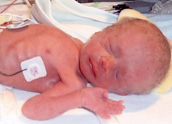
The neonatolgist came over to ask me if I wanted to see my daughter.
My daughter. What a strange, wonderful idea for me to get used to. I
went with him over to the scale where she was squirming around, and tears
came to my eyes. She was perfectly formed, only in miniature.
She weighed 2 and a half pounds, and she didn't need to have help
breathing, which the doctors were pleased about. The only problem she
had was that she was so small. The neonatologist explained everything
to me, but I could only stand there and look at her tiny hands, each
of which was about the size of a quarter. (Here's a picture of her hands when
a few weeks later when she weighed 3 pounds)

I went back to see how Mary was doing, and she wanted to know how the
baby looked. "She's the most beautiful thing I've ever
seen," I said. Then they rolled an incubator over with our baby
inside so Mary could get her first look at the baby. "What's
her name?" the nurse asked.
"Francesca," we replied in unison.
"Francesca! How beautiful!" they said as they whisked her away.
They took us to the recovery room and I started making phone calls.
Then the neonatologist came to take me down to see the baby. He led me
down the elevators and confusing hallways to the NICU, or Neonatal Intensive
Care Unit, a place we would know all too well in the near future. He
took me into the scrub room and showed me the proper way to scrub my
hands for three minutes with the surgical scrub brush. Then I got to see my Francesca again.
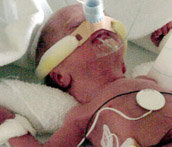
She had a CPAP (continuous positive airway pressure) tube attached to her nose to help
keep her lungs open to help her breathe. She wasn't on a respirator, which is great for a
preemie. The CPAP looked incredibly uncomfortable for her, though, because this tube kept
her head from moving from side to side, and she was obviously annoyed by it as she flailed
her arms and legs about helplessly.
She wasn't in an incubator now because the CPAP made it difficult to position her in
one, and also they needed to be able to get to her quickly in case there was an emergency.
For now she was on a sort of tiny bed with short plexiglass sides with a heating element
that hung over her. On the center of her chest was a temperature monitor to control the
heating element, because preemies can't control their own temperature. Also on her chest
were heart and lung monitors, and she had an oxygen monitor on her foot. All these readings
were fed into a computer screen above the bed.
From these computer screens came a constant series of alarms. When she wiggled around
and the heart and lung leads came loose, the computer screen started beeping loudly to let
the nurses know that there was a loose connection. When her breathing was too slow (apnea)
or her heart was too slow (bradycardia) or too fast (tachycardia), there was a loud "Bong"
sound and a red light on top of the screen went on. Every parent in the NICU lives in
constant fear of this sound, the sound that indicates that their baby is in immediate
danger. Nurses generally pay little attention to the loose lead alarms, but when the
emergency alarm went off, someone rushed to the baby to see if he or she was OK.
The neonatologist and the nurse who was caring for Francesca explained everything to
me, about the tubes that were in her umbilicus for the time being, to supply her with
nutrition and to give them a way to take her blood without poking her. These tubes would
come out in a few days and an IV tube would be placed in her arm.
Mary was moved to the Maternity Ward. After the relatively pampered treatment Mary
received in the High-Risk Pregnancy Ward, the Maternity Ward was terribly depressing. The
room was tiny, barely large enough for the bed and two chairs. The High-Risk nurses came
in every few minutes to make sure Mary was OK, but these nurses largely ignored her. When
Mary needed some water and was unable to walk after her surgery, she pressed the nurse
call button; the nurse answered by intercom (this was how they handled all the calls),
and then never brought her the water. Another nurse came in to change the sheets and
ordered Mary to get out of bed early the next morning. Mary was in excruciating pain and
had a great deal of difficulty standing up. Another nurse threatened to catheterize her
again if she didn't urinate more. All the while, she had to lay there in pain and listen
to other babies cry, unable to hold her own baby.
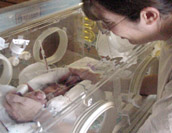
Fortunately she was only stuck in that shoebox room for a few days,
and soon she was home again. Leaving our helpless daughter at the hospital
was extremely difficult, but we went to visit her every day. She made
progress very slowly, each accomplishment one step toward her coming
home...she was taken off the CPAP, she was placed in an incubator, her oxygen monitor was removed.
At first, she was being fed 1 cc of breast milk (approx. 1/5 of a teaspoon)
every 6 hours, then it was increased to 2 cc, then eventually 15 cc,
then 30 cc (1 ounce). Over time she was moved from the Acute Care section
of the NICU to the Continuing Care section (or the "Feeders & Growers").
Time had no meaning as we spent every evening and weekend at the hospital, and Mary
spent every afternoon there to nurse the baby.
Of course, we were never prepared for what happened next...
November 11
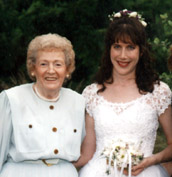
We got a call early in the morning on the 12th that Mary's grandmother
had died suddenly. Mom-Mom (pronounced "mum-mum"),
as she was known to Mary and her sisters, was more than just the sweetest,
nicest lady in the world, she was a genuinely good person. She was the
kind of person who sent a $10 bill for every holiday, even Halloween
and Valentine's day. During Mary's hospital stay, Mom-Mom called
and sent Mary a card every single day, and even after Mary came home,
the cards and calls kept coming. More than anything, Mom-Mom was a good
friend. She had a wonderful sense of humor, going along with all the
sisters' absurd jokes about Mom-Mom being a lesbian drug dealer,
and she wasn't afraid to do her Billy Idol impression.
Mom-Mom's death devastated the family. Fortunately, they had something
positive to focus on at the funeral as they saw pictures of Francesca
for the first time, and everyone talked about how well she was doing
In the meantime, Francesca was doing very well in the NICU, suffering
no major setbacks, and only having minor problems feeding. We watched
with pride as she reached small milestones...we were proud when she got
a hand-colored sign that said, "I'm So Big! Today I Weigh 3 Pounds", and when she was
moved from the incubator into a bassinet.
We watched preemies come and go, and saw some that were in much worse shape than our
daughter, and a few that didn't make it. The parents become friends in the scrub room and
sitting around the incubators, but always are careful not to ask too many questions about
the progress of the baby in case things weren't going well. But for us, things were going
well even though we constantly expected something to go wrong.
December
Finally, after more than six weeks and $300,000 worth of intensive care,
Francesca was allowed to come home. She weighed over 4 pounds, she could
maintain her own body temperature, she was taking all of her feedings
by mouth, and she was gaining weight.
We got a portable monitor for her heart and respiration (more an annoying
series of loose connection alarms than anything real), were shown how
to prop her up in a car seat so she wouldn't slump, and we were
sent home with our baby. The first night was confusing, exhilarating and wonderful.
We were finally a family.

Francesca at 12 pounds










































